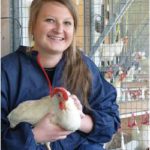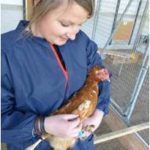My background
It all started with my PhD project entitled “Keel bone damage in laying hens: effects of soft perches, aviary design and selection of bone strength”. With a background in behavioural biology, I started working with poultry on this PhD project in 2011 at the Center for Proper Housing: Poultry and Rabbits, Division of Animal Welfare in Zollikofen, Switzerland. During my PhD, I investigated several aspects that are assumed to be associated with keel bone fractures and deviations: three experiments were conducted focusing on i) perch material, ii) the design of the aviary system and iii) the effect of genetic selection on bone strength. For each experiment, we examined how these factors influenced the prevalence of keel bone damage. To assess keel bone damage, I used palpation as a method though I also dissected keel bones of focal birds to validate the scoring method as well as get a deeper understanding of different types of fractures and underlying potential causes.
Switzerland. During my PhD, I investigated several aspects that are assumed to be associated with keel bone fractures and deviations: three experiments were conducted focusing on i) perch material, ii) the design of the aviary system and iii) the effect of genetic selection on bone strength. For each experiment, we examined how these factors influenced the prevalence of keel bone damage. To assess keel bone damage, I used palpation as a method though I also dissected keel bones of focal birds to validate the scoring method as well as get a deeper understanding of different types of fractures and underlying potential causes.
During my PhD I realised that the topic of Applied Animal Welfare, in particular working with poultry, suited me very well which is why I decided to stay in the field and focus on using my scientific background to work with companies, producers and authorities. A follow-up project of my PhD was thus conducted on commercial laying hen farms throughout Switzerland where we investigated the influence of a prolonged dusk duration in the evening on the number of falls and keel fractures. During this 2 year project, I palpated many birds and encountered different, on-farm specific problems and thereby broadened my knowledge across different settings.
My current work
Since 2015 I am working as a research associate at the Center for Proper Housing: Poultry and Rabbits where I am mainly involved in assessing various types of housing systems and equipment for poultry as part of the authorization procedure of the Federal Food Safety and Veterinary Office (FSVO).
I am also working as a Post Doc at the Division of Animal Welfare at the University of Bern where I am involved in the supervision of PhD and Master students on various laying hen projects such as piling behaviour and smothering, the effect of keel bone fractures on productivity and locomotion, as well as the influence of different aviary rearing environments on the development and performance of pullets.
Continuing with Keel bone damage . . . .
In each of my projects, the assessment of keel bone damage plays an important role and is one of the parameters assessed. The topic of keel bone damage in laying hens and palpation as a method to assess it runs through my scientific career since starting my PhD six years ago. Being involved with the Keel Bone Damage Net has allowed me to strengthen and focus my abilities. I am a replacement leader for Working Group 1 (Improving Assessment of KBD) which aims to coordinate and initiate efforts to improve accuracy, comparability and repeatability of the assessment of keel bone damage which is key to objective, reliable data. One approach that I use to improve myself in regard to palpation is comparing the palpation score of a birds’ keel bone with radiographs of the same keel bone. Assessing my own palpation technique and calculating its accuracy helped me a lot to fine-tune and adjust my scoring abilities accordingly.
One of my other tasks within the Action is co-organizing a Training School that will be conducted in August 2017 at the Center for Proper Housing in Zollikofen to validate and adjust palpation as a technique to assess keel bone damage using X-ray.


